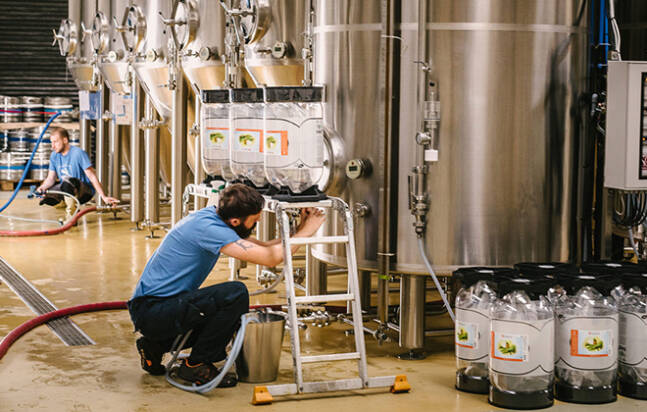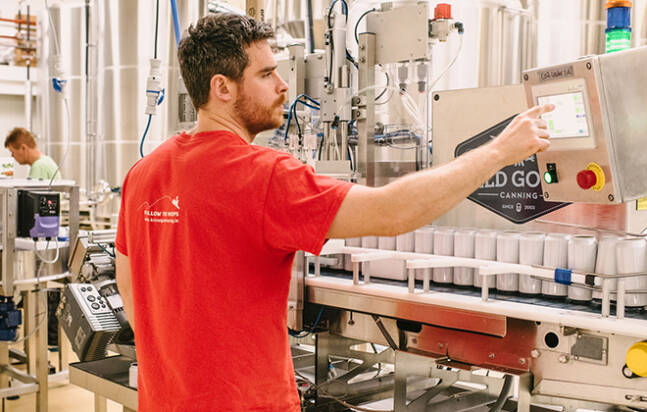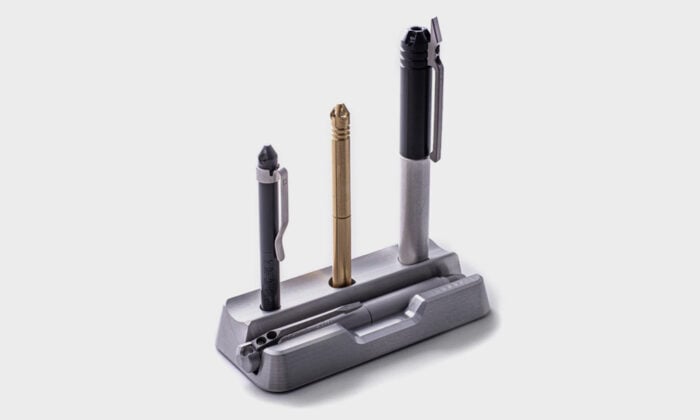I spent the last three months of 2022 working at Kinnegar Brewing, an Irish craft brewery in Letterkenny, County Donegal. For homebrewers who want to learn what it’s actually like to work in a brewery, an internship like this provides invaluable lessons—including lessons that can be applied to being a better homebrewer.
Kinnegar has been riding the Irish craft wave with consistent expansions in both production capacity and beer choices since the brewery’s founding in 2011. It’s owned by husband and wife team Rick LeVert and Libby Carton. He’s American, she’s Irish.
As a production intern, my focus for three months was on production and packaging. The K2 facility, as the Letterkenny location is known, works off a 35 hectoliter brew kit and fermenters at 35 and 70 hectoliters, as well as the original 10HL brew kit from the early years of production, which mostly functions as a pilot system now. All the packaging is done in house, with canning and bottling lines and a keg filler. Distribution is handled by a couple different companies around Ireland and the North, as well as a decent foothold in the continental market. As of right now, Kinnegar doesn’t export to the United States, unless everyone there did a great job of hiding those shipments from me.
If you want to try their beers for yourself, which you definitely should, your best bet is to get yourself to Ireland where the core line is available in many shops and pubs around the island. From the flagship beers to limited-availability experimental releases in the Brewer’s at Play (BAP) and Tap Room Only (TRO) series, all are worth searching for.
The Financial Realities of a Brewing Internship
I’ll include my standard “anecdotal evidence” caveat when I say it’s insanely hard to get work experience in production brewing. This internship with Kinnegar was my first breakthrough after about five years of searching (including two pandemic years) and even then only happened because I was in the area visiting friends from grad school. I took a day to visit the brewery and sit down with Carton to see if the internship would be a good fit for both of us. We both left the meeting thinking it would, she confirmed that with whoever she needed to, and I got an official offer letter in my inbox a few weeks later. Even then, because of regulation around residency, I could only stay for three months. There was also no shot of me turning the internship into a full time, visa sponsored job, which Carton was very up front about.
I should also include some financial transparency here in case any of you are thinking about flooding Kinnegar with internship requests. Unpaid internships are generally fraught with legal issues and loophole abuse as well as being a major reinforcer of the American caste system. Kinnegar offered me a stipend of 120 Euro a week, which obviously isn’t a dragon’s hoard of gold but at least took the pressure off my rent. I dodged the Irish housing shortage by using friend-of-a-friend connections in the area to commandeer a granny flat that was usually used by the homeowners’ children. The rental car, a Toyota Yaris, was my other major expense. It was funded by the Millennial-standard bank of Mom and Dad when the government realized it still owed her for pandemic unemployment. If the state of Delaware didn’t altruistically resolve its outstanding debts, I wouldn’t have gotten the car.
My freelance work was ongoing and paid for everything else, including food, my cell phone, my social life, and gas for the car.
To sum everything up, I was moving for a close-to-unpaid internship that was the result of five years of searching that I only got because I was coincidentally in the area visiting very close friends I’d met years prior.

What a Brewing Internship Is Like
That first conversation Libby and I had in April 2022 revolved around figuring out what the hell I was even coming to Donegal for. She didn’t put it that way, though. She asked what parts of the brewery I was most interested in. I told her I’d do it all, and we landed on a 60/40 split, where most of my days would be spent cellarside and I’d be called over to packaging on slow cellaring days or when packaging really needed the hands.
I think I did every job production had to offer, including spending a full day on the brew kit with LeVert. I cleaned everything, pumped beer from tank to tank, took gravity readings off wort and beer, dry-hopped so many tanks I had dreams about it, put innumerable cans and bottles in cases, laid out grist, milled that grist, waded through yeast, hops, and coconut waste, and cleaned and filled what felt like a keg of beer for every pub in Ireland. Evidently, I was a good enough intern that they kept me on for the full three months and even let me come to the staff Christmas party.
Given how many different things I did, I don’t know that I would say I was particularly proficient at any single thing in the facility. What I would say is that I have a reasonable amount of confidence in my technical ability. I don’t really get nervous when I’m learning a new skill or a new way to handle an old skill because I have a solid foundation from all those other times I learned new things.
I should say a lot of that comes from the quality of the teachers I’ve had, which is actually a good segue to one of the more important things working in this kind of job teaches you.
Learning to Immediately Own Mistakes
In both breweries I’ve worked in, one of the first things that was hammered into my head was it’s infinitely easier to correct a mistake in the moment and, if you did, nothing was truly irredeemable. It’s a hard thing to believe, considering how unreasonable some bosses get when you admit you screwed up, and I’ve certainly been burned before. I can’t speak for every single employee, obviously, but any time I personally messed up at Kinnegar, I was shown how to lessen the worst of it, if not outright fix the problem.
Again it all comes down to the quality of the people I interned under. One of the brewers at Kinnegar took the approach that if I did something wrong out of ignorance, that mistake is his own responsibility. He didn’t teach me and I didn’t know and now there’s a bigger problem, all of which means he didn’t do his job. The other side of that arrangement, though, is if I’m still making the same boneheaded mistakes after I’ve been repeatedly trained on something, that’s my fault. I’m either being willfully negligent, which is really bad, or simply not suited to the job, which is bad but not existentially threatening and can be mitigated.
I’ll admit one of my biggest mistakes dropped my boss’s face as soon as I told her what I did. I pumped hot water back into a double batch of Kinnegar’s most popular beer, Scraggy Bay. It was a mistake I recognized quickly and brought to the production supervisor as soon as I saw what I did. We did our tests to make sure water hadn’t contaminated the beer, which it hadn’t, and ended up packaging the beer as normal a few days later. I got away with it on that one, but if something had gone wrong and I’d tried to cover it up, the cascade of problems would mean disrupting the brewing and packaging schedule as well as weeks of me trying to dodge questions as they troubleshot the beer. All when we could have dumped the beer and gotten another into the tank within a few days.
Owning your mistakes also isn’t a brewing-industry specific benefit, it’s a life and relationship improving philosophy. The book Mistakes Were Made, (But Not By Me) dives deep into the psychology of mistakes, analyzing both the extent the average person will go to to cover up something they’ve done wrong and how much the average person respects someone who takes responsibility for what they’ve done. (And it usually tells these lessons through higher stakes examples than having to dump a few thousand liters of beer.)
It’s one of those ideas we all rationally know is true, but also often avoid the herculean effort it takes to apply to our own lives. It’s the difference between hearing something fall in the fridge and leaving it shut or opening it again to put whatever it was back on the shelf.

Adapting To a European Measurement System
Metric’s superiority is in its ease and efficiency in industrial applications, not in how much it improves a normal person’s life. In industry, one person using metric and one using imperial means things will start collapsing or exploding. In casual conversation, it means one person has to do a tiny amount of mental math.
These are wildly different stakes, but you wouldn’t know that from the European reaction to any time I said a temperature in Fahrenheit. No American I’ve ever talked to has ever had any stronger reaction to a temperature conversion than “double it and add 32,” but instead of thinking, “65 Fahrenheit is roughly 19 Celsius and now I know what he’s talking about,” Europeans decided I’m a maniac who can’t be trusted to make rational decisions and should be taken to a psychiatric ward until I’ve been rehabilitated into a productive member of society. Casual conversations about the weights of produce at the grocery store devolved into shouting rants about why America is a pagan nation stubbornly bent on worshiping the old gods of pounds and ounces.
But to be clear, every aspect of the brewing process is improved by using metric. Figuring out grain proportions is unquestionably easier when your measurements increase and decrease by multiples of 10. Temperatures are much easier to understand and maintain if it’s all related to water, especially when that’s the main ingredient in what you’re making in the first place. Hop additions are far more precise in grams with decimals instead of ounces with fractions. That the American breweries and distilleries I’ve worked in and visited measure in barrels and gallons instead of liters desperately needs updating. It’s anachronistic, inefficient, confusing, and increases the potential for stupid, beer-ruining mistakes.
And if my anecdotal evidence from my American engineering friends is anything to go on, brewing and distilling are lagging behind most other industries. Metric is already used in the industries where conversion would be most important. NASA talks about the distance to the moon in kilometers and medicine is administered in little bottles and syringes marked by milliliters. Europeans already won the argument about which system is more efficient, and Americans use it everywhere it matters.
Get Personal With Your Beer
A few years ago, when I was doing research about what Eisenhower’s interstate system did to American cities, I stumbled across a Ted talk from an old college professor of mine. He talks about a lot of different ways highways have changed American life, but the central point was how they divorced the American people from their food supply. Agriculture has been largely depersonalized with a huge corporate infrastructure between you and your food.
There’s an element of that in beer as well. It’s not as profound, in the sense that most craft breweries have the name and location on bottles and cans. But the breweries that are large enough to distribute aren’t usually exclusively operated by the head brewer or owners. Most of whose names you never get to hear.
At Kinnegar, Chris and Dave handle most of the brew days LeVert and Canton don’t, while Alberto and Iggy make sure that things are happy and healthy in fermentation vessels before they move everything over to a brite tank for packaging. Chris (a different, but still Scottish, Chris), Angela, and Paul put the cans and bottles into cases, then lug pallets around the facility to make sure things are ready for distributor pick ups. Paul also has to deal with murderous Letterkenny traffic since he handles most of the local deliveries. Rachel and Jack oversee brewside and packside, respectively, which really means they’re doing every job all at once. Gavin, the engineer, keeps the brewery together with some kind of improvisational welding and reliably Irish “Ah, sure, be grand” philosophy. There’s also a bunch of fluidity in the workforce and some people had a lot of crossover in their responsibilities, similar to how I’d work packside or brewside depending on the day. Then there’s Sean and Löic in marketing; the other intern, Veronika, a German who spent most of her time huddled over a microscope in the lab doing science things I didn’t fully appreciate; and Laurie, who was put on the injured reserve in an unfortunately punny collision with a lorry but still dragged himself into the place to help out with packaging and inventory.
Working as closely as I did with everyone gave me a new appreciation for the fact that everything has to be made by living, breathing people. That’s true of every product you’ve ever bought, from cheap Happy Meals to cars and houses. An endless web of people, all with names, lives, and personalities, weaves together to create the products we use everyday.




